We may earn revenue from the products available on this page and participate in affiliate programs. Learn More ›
If ever a topic begged for alliteration, it’s coyote cartridges and calibers clearly and concisely contrasted and compared. But we won’t stoop to that here. We’ll just outline three of the most popular and effective cartridges employed by serious coyote hunters these past four decades.
But, before we jump into the ballistics of the .223 Remington, .22-250 Remington, and .243 Winchester, we should remember why anyone bothers hunting what is generally considered an inedible critter (even though some meat eaters are now imbibing.) The reasons are several, among which two are most often cited:
1. Valuable pelts—They might fetch anywhere from $10 to $200 depending on the market and quality. This should be celebrated by environmentalists because coyote fur is not only beautiful and warming, but all-natural, biodegradable, organic, free-range, abundant and sustainable. Coyotes are Nature’s own renewable clothing resource. Wearing fur instead of turning up the thermostat reduces your carbon footprint, too. Fight climate change! Wear fur.
2. Balancing the scales—Overly abundant coyotes have been proven to severely deplete populations of prey species including woodchucks, pronghorns, mule deer, and similar-sized game. They are not significant predators on birds, but they have attacked small children.
There are a few more reasons to hunt coyotes. East of the Mississippi, they are truly an invasive species. Even across much of the West, where they are native, they were historically kept in check by large numbers of wolves. By changing habitats, we humans have enabled excessive increases in coyote numbers. It’s our responsibility to correct some of that.
So you’d better have the right rifle and cartridge…
Rifles
Of course anything from a single-shot .22 Long Rifle to a semi-automatic .50 BMG will suffice, but both are at extreme ends of the acceptable scale. Aside from sensible cartridges, appropriate rifles contribute to success. Experienced coyote hunters have been relying on traditional bolt actions for decades because they are durable, reliable, and fairly easy to tune to shoot precisely. Called coyotes are usually engaged inside of 200 yards, often 20 yards, but they can also hang up beyond 300 yards. They provide about a nine-inch broadside target, perhaps just a four-inch kill zone when head on. And they’re often coming head-on. So an accurate rifle is a must.
The potential for multiple shots on coyotes is driving the current trend toward autoloaders. During the peak of the fur market in the 1970s coyote hunters were increasingly looking to the Ruger Ranch Rifle, a semi-auto in .223 Rem. These days the versatile AR-style semi-autos are quite popular and deadly accurate. There’s nothing wrong with Browning’s BAR or BLR in .243 Win. either. Choose whatever action-style you like, but do think about quick, smooth follow up shots. Here we go.
.223 Remington
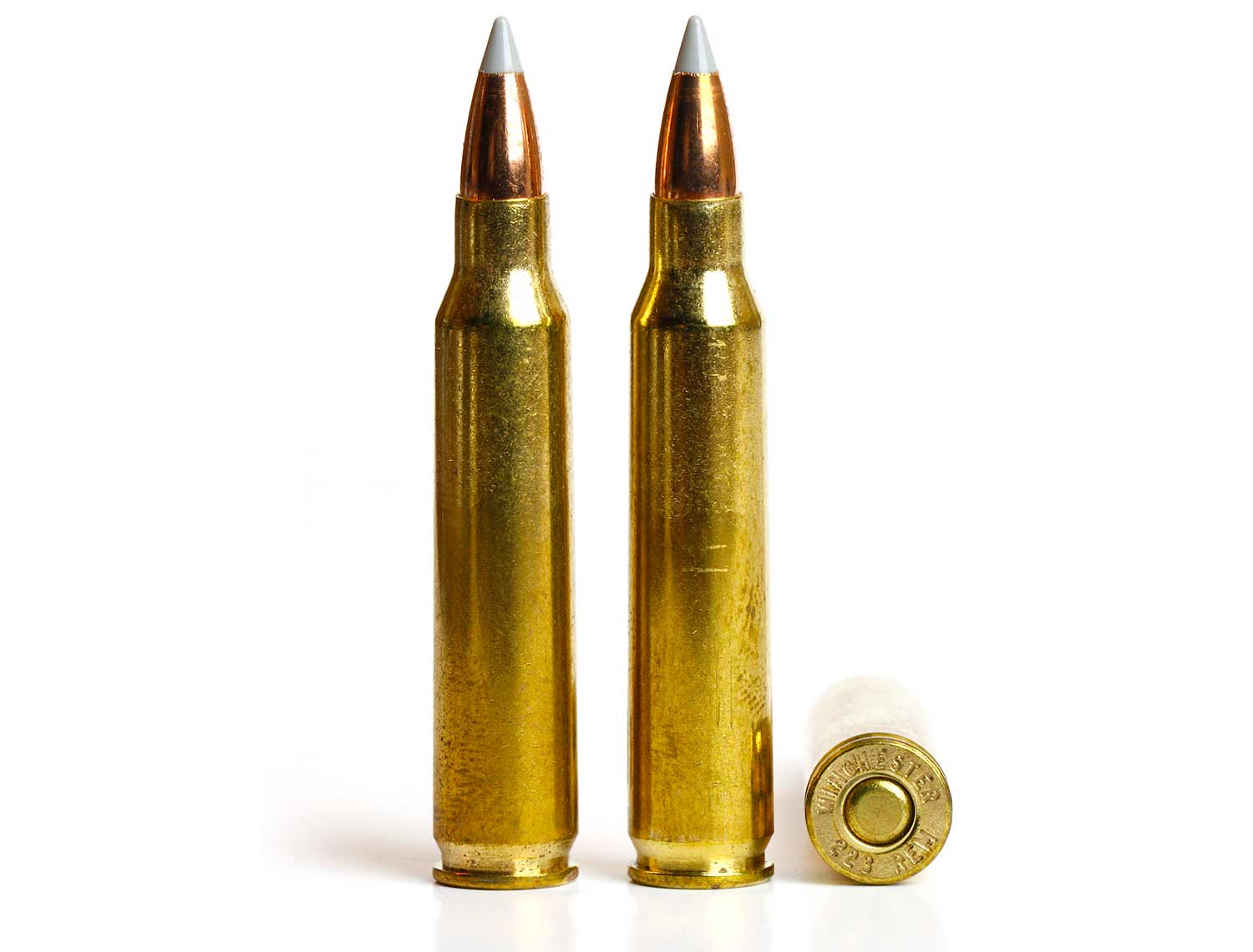
The allure of .22 centerfires seems to be minimum cost, recoil, and fur damage combined with long reach. The ubiquitous .223 Remington addresses most of these very well.
Fast .22 centerfires have been high on fur-collectors’ cartridge lists since the .22 Savage High-Power or Imp first hit the scene in 1912. This was just 16 years after the introduction of the .30 WCF (30-30), our first smokeless powder sporting cartridge. The Savage pushed a 71-grain bullet 2,790 fps. It was so novel that a few wealthy sports used it to deadly effect on lions and Indian tigers. There followed many centerfire .22s like the .22 Hornet, .222 Remington, .222 Remington Magnum, .224 Weatherby Magnum, .219 Zipper, .218 Bee, .220 Swift, .225 Winchester, .22-250 Remington, and this .223 Remington. Why has it come to dominate sales?
Because it was officially adopted by our military as the 5.56x45mm in 1964. It so closely matches in size, shape and performance the .222 Remington Magnum that we could ask why it was ever created. Remington wondered the same thing. It had built its .222 Rem. Mag. in an attempt to have it adopted as our new military round in the AR-15. When it was rejected, Remington commercialized it in 1958 as a “magnum” version of its already popular .222 Remington.
Despite this Mag’s six-year head start, Remington knew it would quickly fade once cheap 5.56×45 military brass began pouring out of rifles. So Remington commercialized the 5.56mm as the .223 Remington. Smart move.
Today the .222 Remington Magnum is obsolete and the .222 Remington is close behind. But everyone and his sister’s girlfriend shoots a .223 Rem. This narrow (.378” head) and short (2.260” COAL) centerfire holds about 27 grains of water when loaded with 50- to 55-grain bullets. You can stuff them with 60-grain and heavier slugs, too, but most commercial rifles don’t have fast enough twist rates to stabilize these longer bullets. Most .223 Remington rifles are built with 1-12 twist. Many, if not most ARs in .223/5.56×45 roll with 1-8 or 1-7.
We might as well address cartridge interchangeability right here. Dimensionally the .223 Remington and 5.56×45 are identical. The trouble arises with heavier bullets and higher pressures in some 5.56×45 loads. It is commonly accepted as safe to fire .223 Remingtons in 5.56×45 chambers, but not vice versa.
While the .223 Rem. handles bullets from 35 grains to 60 grains, even 79 grains in custom fast twist barrels, the standards are 50-, 52-, 53-, and 55-grains. A 1-12 twist barrel will stabilize the 55, but not always the 60s. Although the 50-grain can be driven faster (roughly 3,400 fps in most factory loads) than the 55s (about 3,240 fps average,) coyote hunters sometimes find it a bit light for bigger dogs. An extra 5 grains might not sound like much, but in .224 it makes an appreciable difference in retained energy and wind deflection (forms being similar.) So let’s check the trajectory of one of the higher B.C. 55-grain .224 boat-tails on the market, the Sierra BlitzKing at .271 B.C. Sierra’s handloading manual indicates we can push it to 3,300 fps from a 24” barrel. We’ll zero it and all cartridges for a 5-inch target zone, maximum ordinate no higher than 2.5 inches. That’s plenty of room for a safe center mass hold on even a small coyote. We’ll figure maximum point-blank range (MPBR) will be the distance at which our bullet falls 2.5 inches below point-of-aim.
As you can see, we have ourselves a solid 275-yard MPBR coyote rifle here. With a laser rangefinder, turret dialing, or a ballistic reticle for holdovers, skilled shooters can take it well beyond that but dwindling energy levels after 300 yards start to raise questions. The average coyote weighs around 25 pounds, but a massive old male, especially in the NE where they’ve apparently hybridized with wolves and dogs, can reach 50 pounds. You might begin to question wounding efficiency with a 55-grain bullet carrying 600 ft-lbs of kinetic energy. I’ve chest-punched coyotes with 130-grain .270 Winchesters and 180-grain .300 Win. Mags. inside of 100 yards and watched them dash off 30 yards before expiring. However, I’ve also center punched them with .224 bullets carrying less than 600 ft-lbs and gotten decisive kills, DRT.
Recoil in a 7.5-pound rifle is almost nothing: 4 ft-lbs at 5.8 fps. This is one of the virtues of the .223 Rem. Not only is it easy to shoot precisely without fear of recoil or even significant muzzle blast (but wear hearing protection anyway!), but it’s fairly easy to see your hits, recover from recoil, and stay on target for follow up shots. A huge variety of ammo widely available at low prices combine to make the .223 Rem. a good option for coyote hunting. These attributes plus minimal pelt damage argue strongly for the .223 Rem. The biggest shortcomings are long-range drop, energy, and wind deflection. These aren’t horrible, but we should judge them in light of our next two cartridges’ performance.
.22-250 Remington
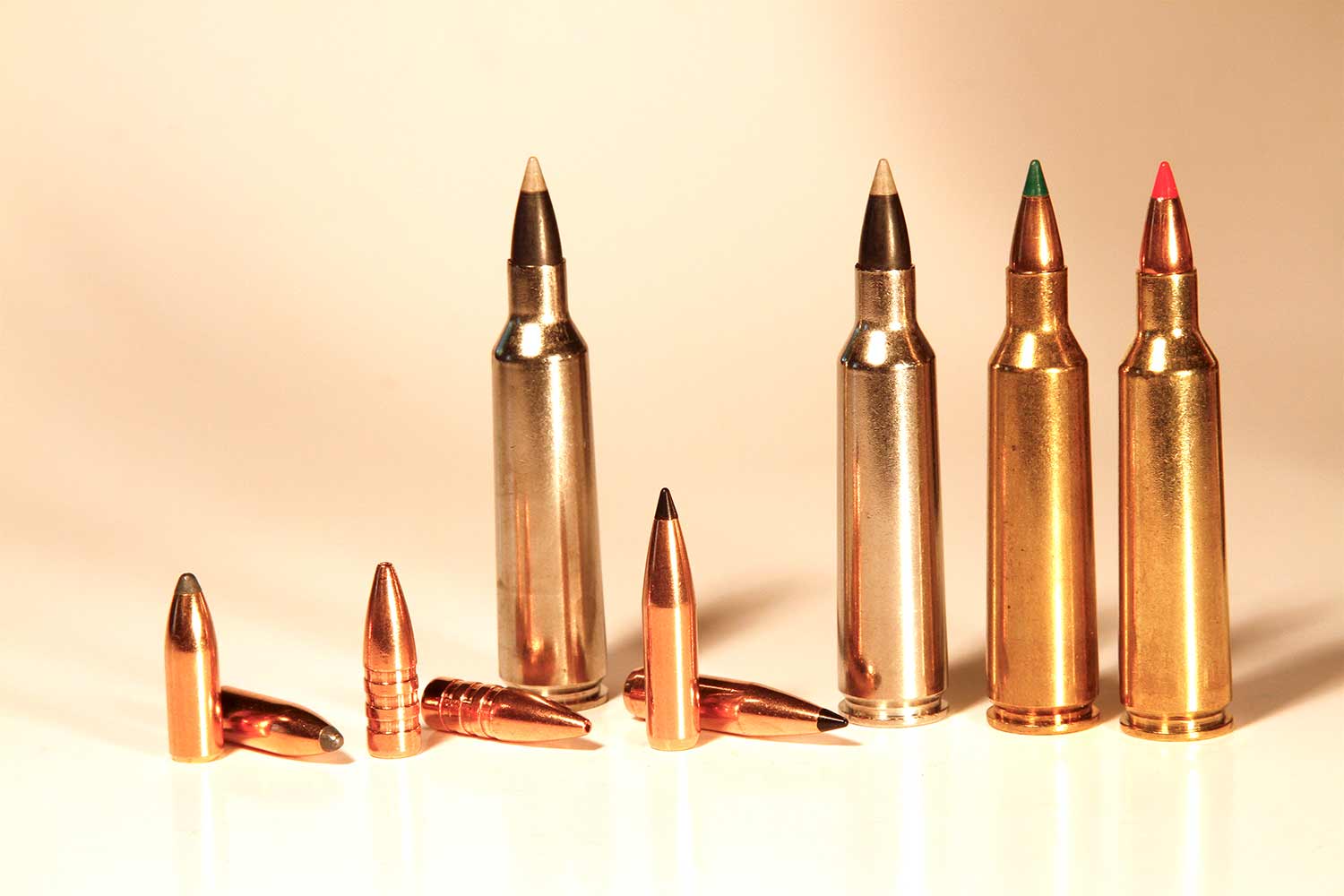
I don’t know why, but just as Winchester seems to rule the .30-caliber markets (.30-30, .308 Win., .300 Win. Mag.), Remington seems to own the .22-caliber category. It introduced the .22-250 Remington in 1965 while the Beatles were dominating the radio with I Feel Fine, Ticket to Ride, Eight Days a Week, Help!, and Yesterday. The cartridge should have been legitimized by someone long before that. It was a common, beloved wildcat (.22 Varminter) way back in the 1930s. Better late than never. With its Remington imprimatur it took off, dominating the charts with 55-grain .224 bullets screaming from 24-inch barrels an average 3,600 fps.
It should be noted that Winchester’s .220 Swift was beating that by about 200 fps and had been since 1935, but too many shooters were perhaps leery of its barrel burning tendencies. Popular writer Robert Ruark didn’t help the Swift’s reputation when he cursed it in print after wounding a hyena with several shots. He didn’t bother to consider the frangible, 48-grain varmint bullet might have been the culprit.
At any rate, the .22-250 remains our most popular upper-end .224 to this day. Not even the faster .223 WSSM could dislodge it. Shot rapid-fire on rodents, the .22-250 Rem., too, will chew through barrels pretty quickly, but as a coyote getter, it’ll last a long, long time. The coyotes, not so much. At 3,600 fps the same 55-grain BlitzKing fired in our .223 Rem. will hold 600 ft-lbs energy to 400 yards and extend MPBR to just beyond 300 yards. I can promise you this has worked for well over 90 percent of my coyote hunting chores over the past 40 years. In most cases, coyotes hit at 400 yards crumpled just as quickly as those at 40 yards. Generally, a solid chest hit results in a resounding “whump” followed by a “where’d he go?” question from the shooter who didn’t see the coyote fall in a heap.
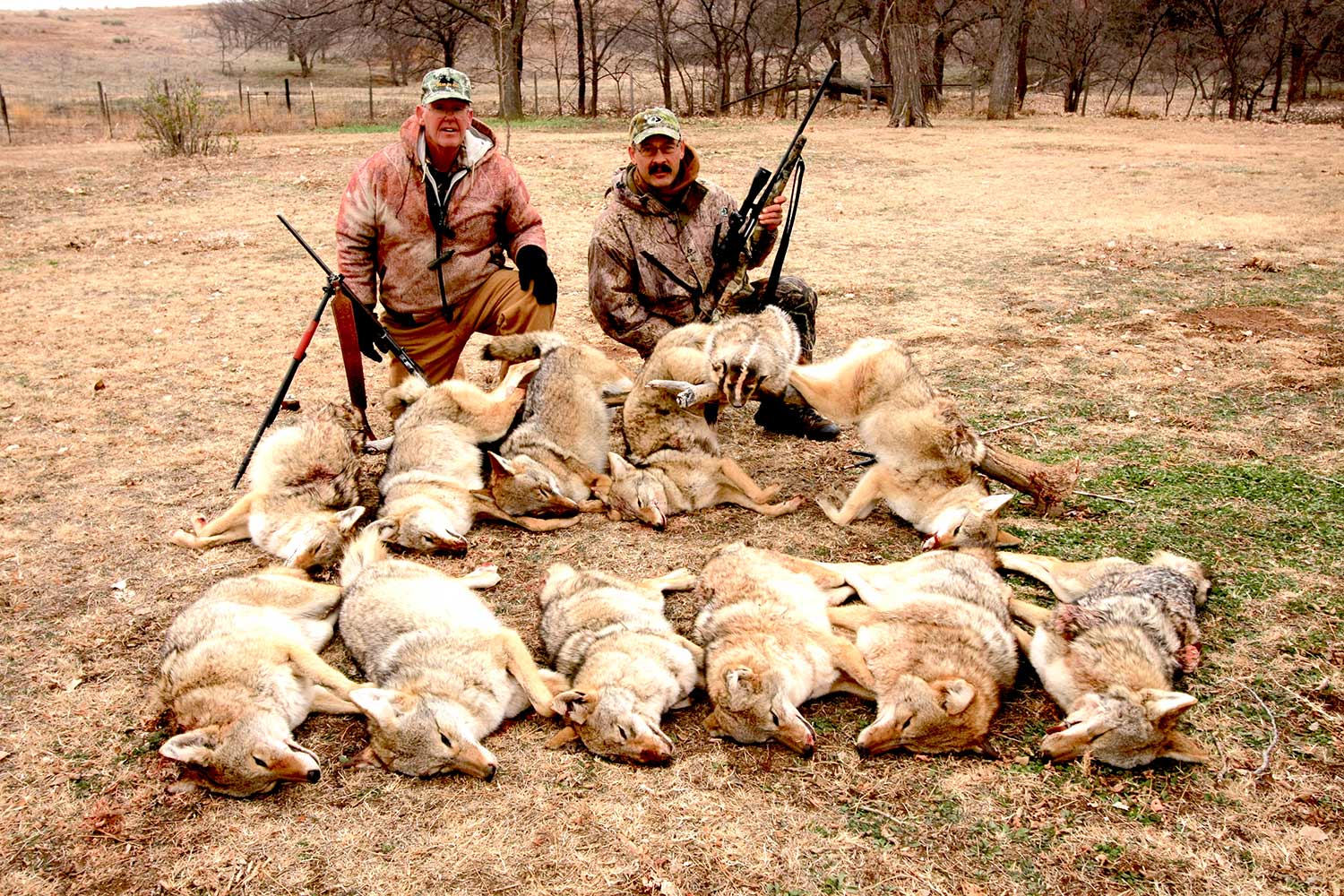
Obviously, this cartridge fires the same .224 bullets as the .223 Rem., but with its fatter (.473” head) and longer (2.350 COAL) case, it has more powder volume (47-grains water capacity.) This cartridge was engineered by necking down the .250-3000 Savage case, thus the “250” in its title. As such, it has a bit more body taper than is popular in more modern cases like the 6mm Creedmoor. This doesn’t seem to bother coyotes. Nor .22-250 lovers.
Thanks to the extra powder in this case, recoil in a 7.5-pound rifle will be around 6.4 ft-lbs at 7.4 fps. Still too mild to induce a flinch, although recoil can throw you off target a bit more. Suppressors help with this, but so does additional rifle weight. Hunters who glass and pick off coyotes at longer ranges often use 9- to 11-pound rifles. I prefer a quick-handling, light rifle for my more active style of running, calling, and gunning. Hard-charging coyotes have, on occasion, ended up in my lap.
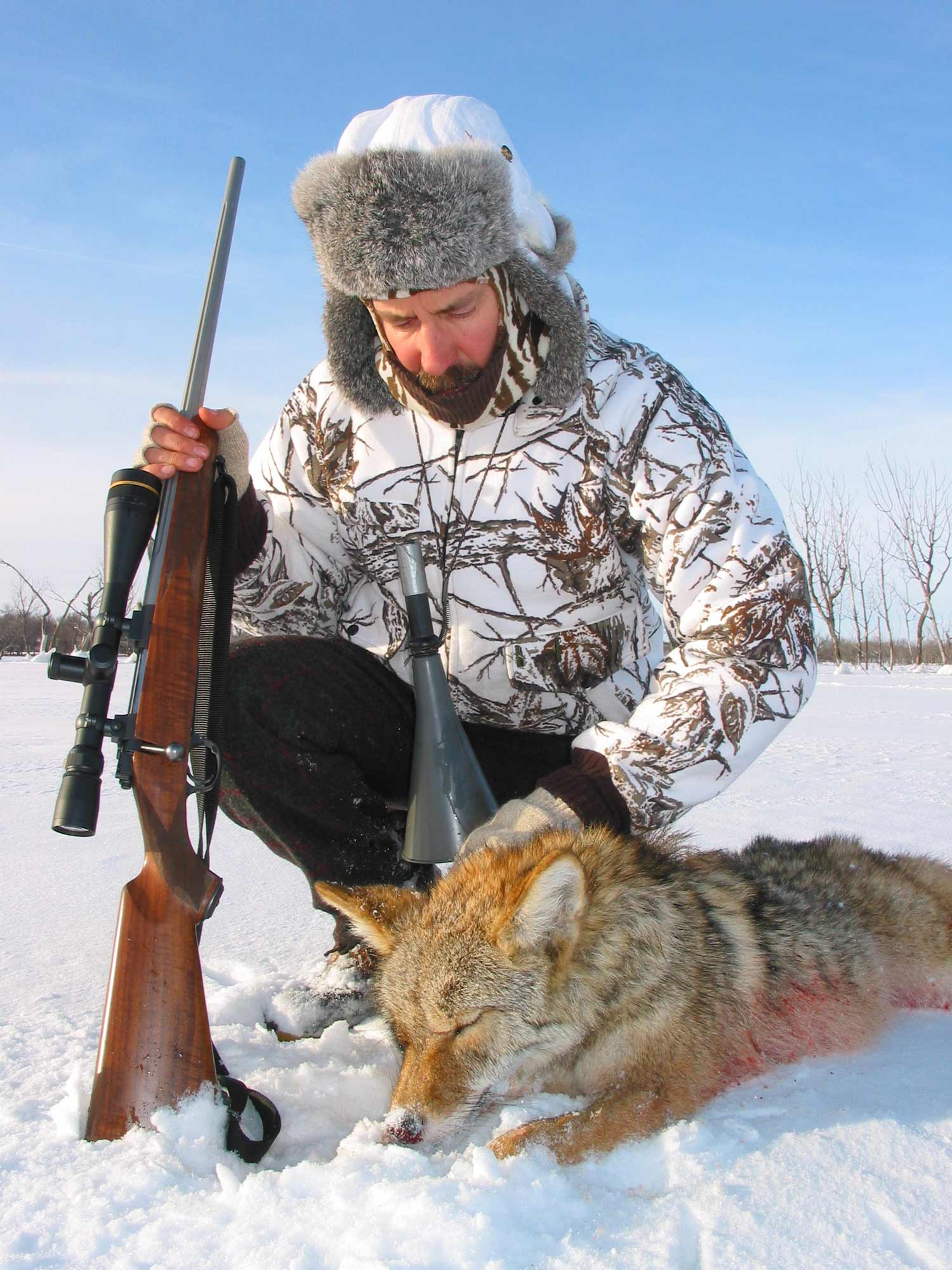
Advantages the .22-250 provides over the .223 Rem. can be seen on the trajectory tables. Figure roughly 30 yards more MPBR, slightly less wind deflection, and about 100 to 150 ft-lbs more energy at 300 yards. The price for this is a few dollars more per box of ammo and just enough extra recoil to prevent you from seeing some hits. I’d give the nod to the .223 Rem. for fast action, multiple shot flurries at close range, the .22-250 for longer range sniping and more decisive kills. Pelt damage can be a bit worse with hits “near the edges.” These tend to tear hides, but needle and thread can usually repair the damage.
After five decades in the coyote fur gathering business, I’ve settled on the .22-250 Rem. as my favorite, but I frequently use, and certainly can’t argue against, this next contender…
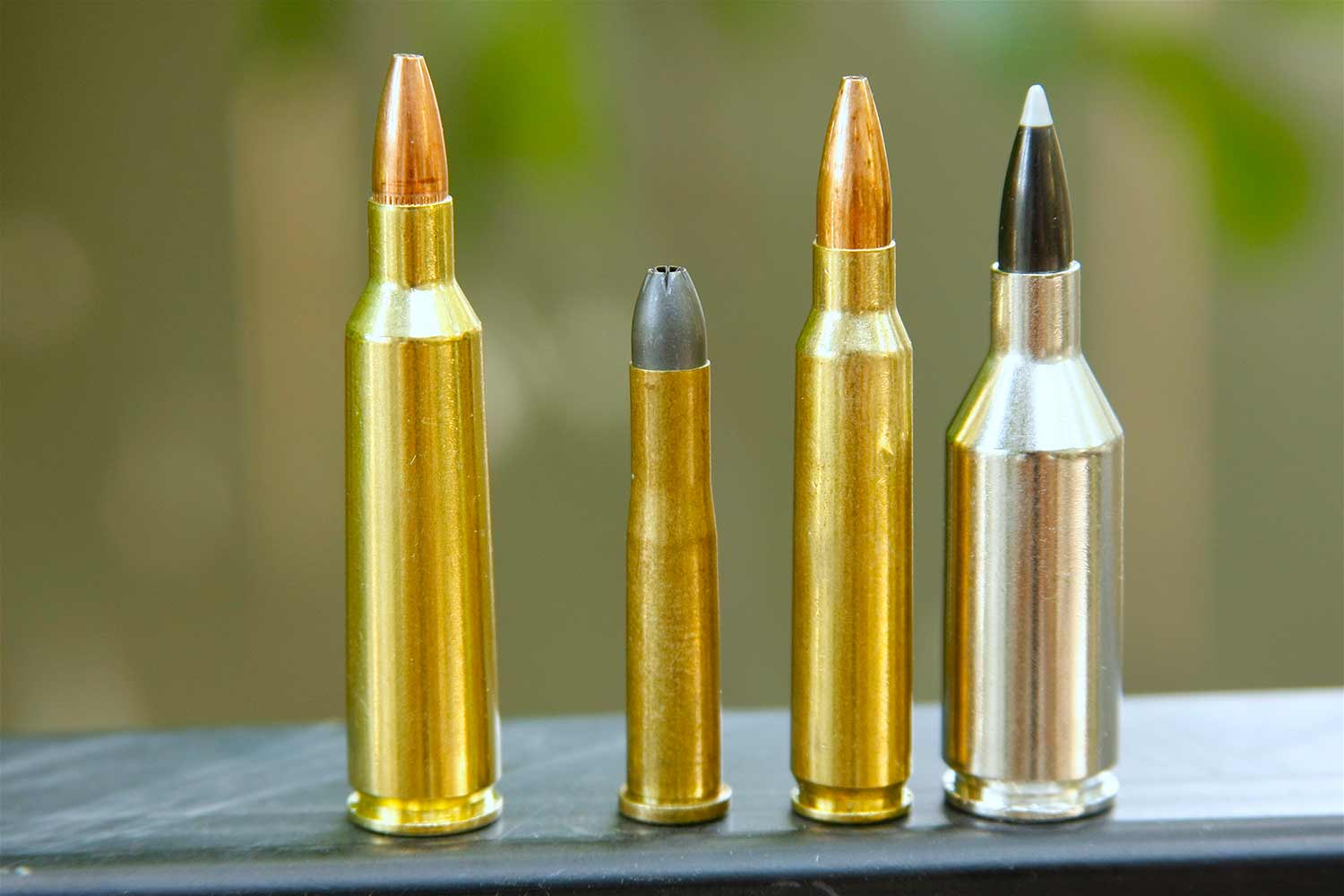
.243 Winchester
Some say this necked down .308 Winchester is a bit too light for deer, a bit too powerful for rodents and chucks, but perfect for coyotes. I think it’s remarkably effective on all of them. This 24-caliber spits .243-inch bullets weighing 55-grains to 100-grains anywhere from 3,700 fps to 3,000 fps from a 22-inch barrel. Add about 100 fps for a 24-inch tube.
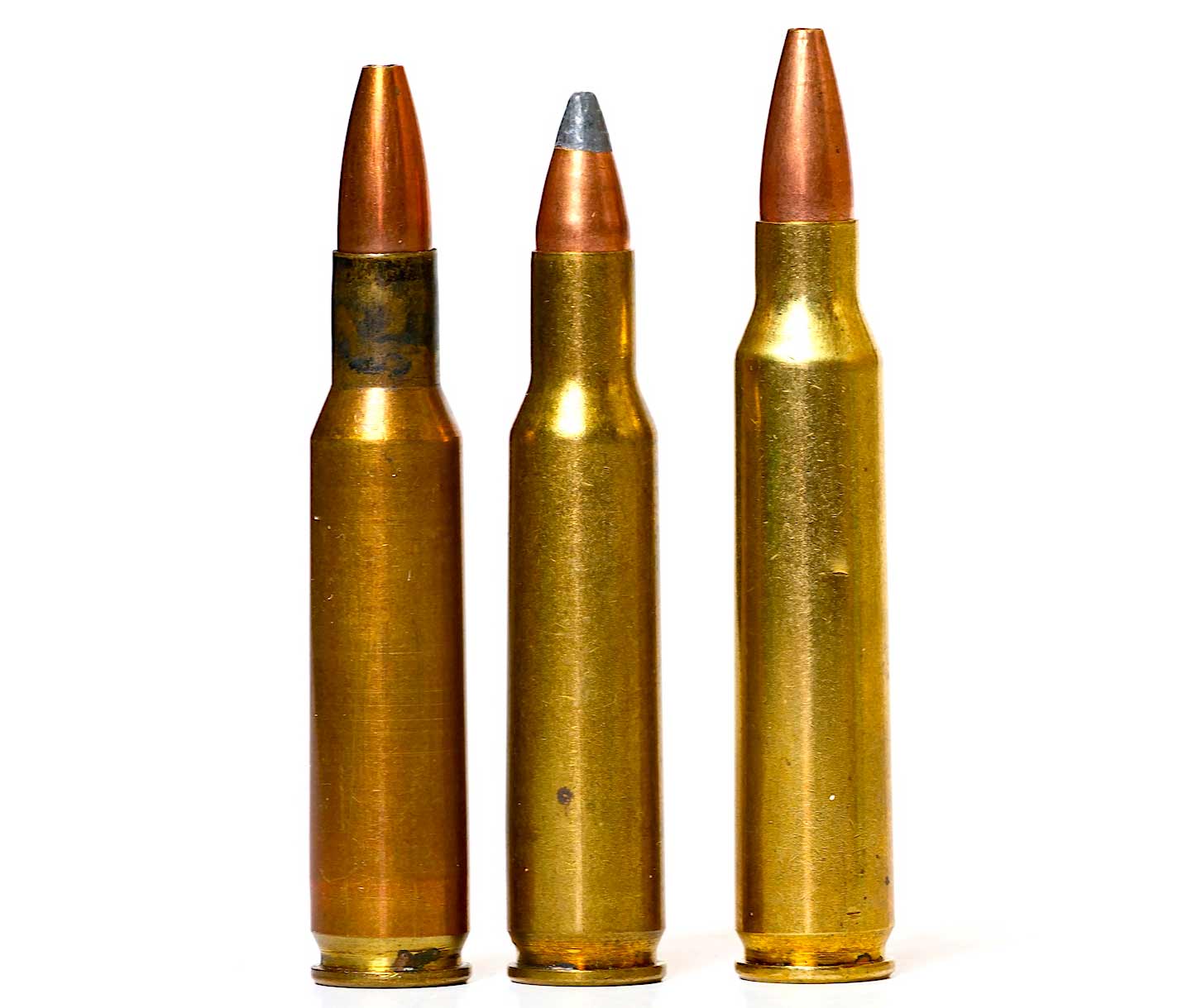
The advantage the .243 has over our other contenders is horsepower and reach. To minimize wind deflection and maximize on-target energy, you can roll with a 90- to 100-grain boat tail spire point. Some of the latest, like Berger’s 95-grain VLD Hunting are rated a G1 B.C. of .467. That’s almost double the B.C. rating of the 55-grain .224 bullet above. A dose of about 44 grains of Ramshot Magnum powder should push this sleek bullet 3,000 fps from a 24-inch barrel. Let’s see how that plays out:
As the Range and Elevation columns point out, drop is twice that of the .22-250 at 300 yards, but look at that windage column (5th from left.) The higher B.C. .243 bullet is deflected 2 inches less in a 10 mph right angle breeze at 300 yards. That’ more than enough to turn a miss into a hit. Wind being the most unpredictable variable afield, you might want to run with this rather than flatter trajectory. But…
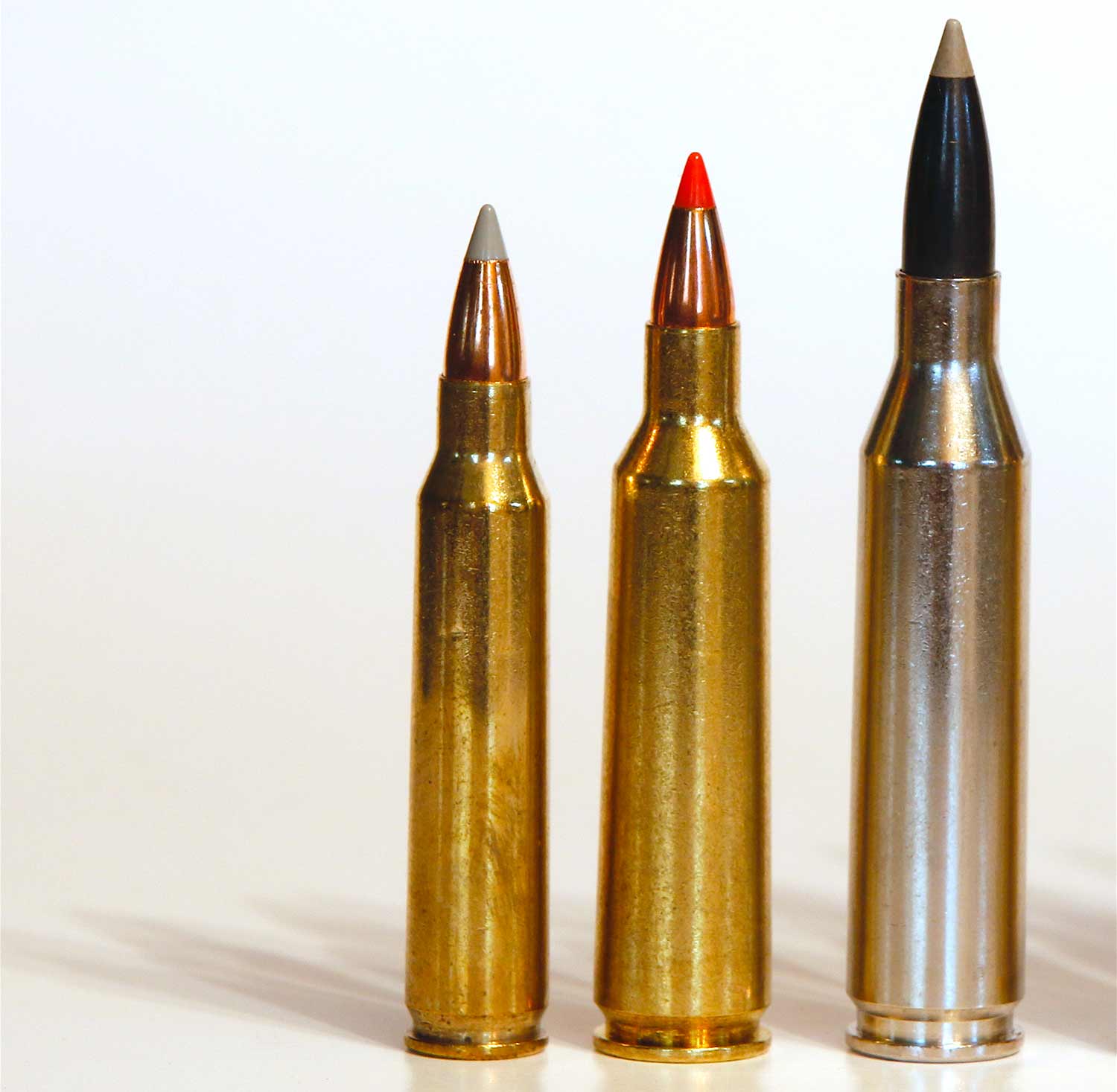
If you hunt where wind rarely blows, step down to something like an 80-grain Nosler Ballistic Tip at 3,400 fps and watch the trajectory flatten:
Now we’re within a half-inch of .22-250 Rem. drop at 300 yards and still maintain a 1-inch wind deflection advantage. Admittedly these are not huge differences. The real .243 Win. advantage is in retained energy at all ranges. Study those Energy columns and you’ll notice about 300 ft-lbs more energy in the 80-grain .243 than the 55-grain .224 at 400 yards.
Recoil from that load in our 7.5-pound rifle should be just over 10 ft-lbs at just a whiff over 9 fps velocity. Still delightfully easy to shoot. Ammo availability is extensive. And you can flatten trajectory even more by stepping down to 70- and even 55-grain bullets, but you’ll sacrifice your wind advantage.
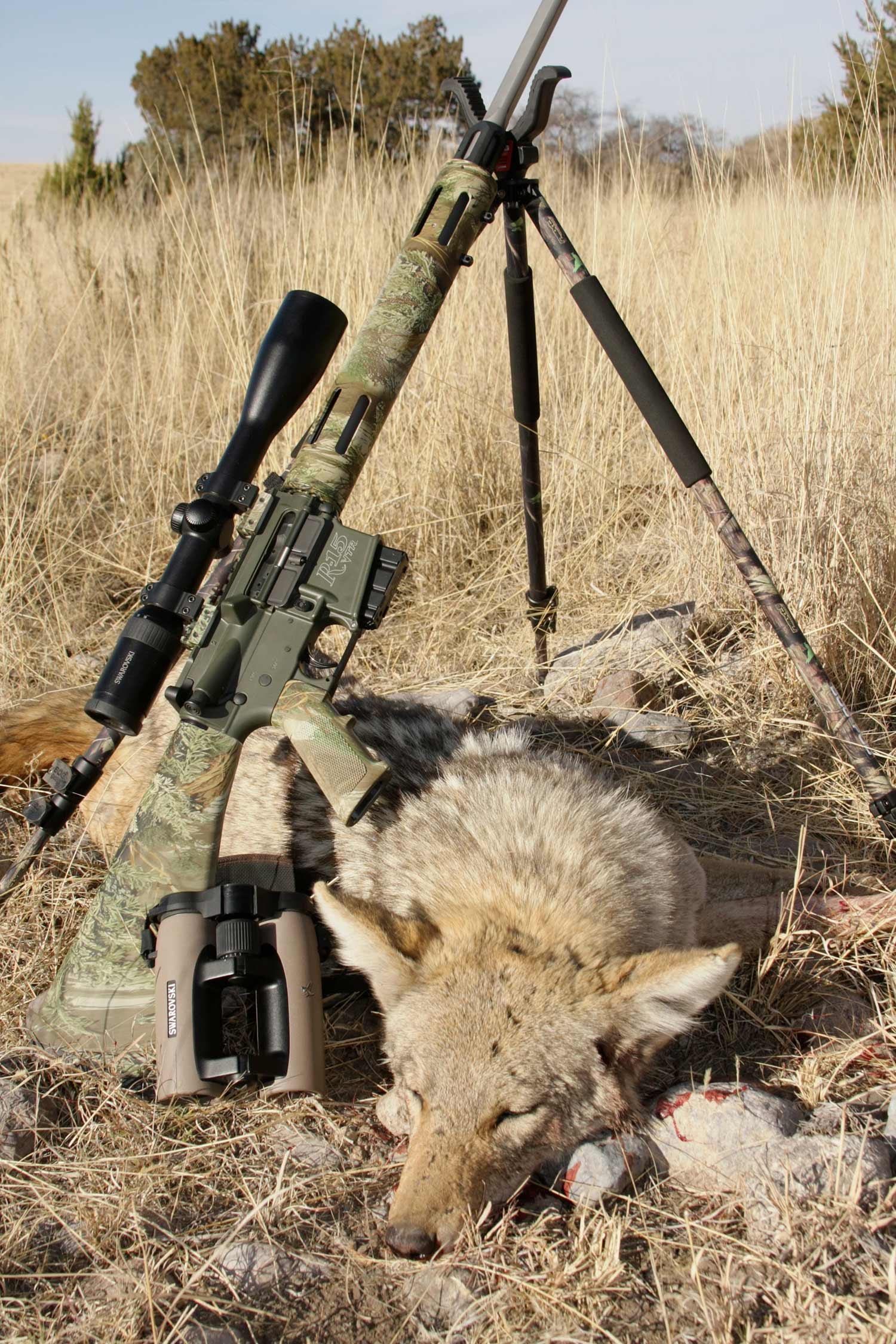
Conclusion
There are other cartridges that provide equal or slightly better trajectories, but at significantly higher costs, recoil levels, and pelt damage. Perhaps we can detail them in a future article. In the meantime, if you’re eager to get started coyote hunting this winter, either of these three, time-tested and “coyote-disapproved” cartridges would be good to ride the river with.
